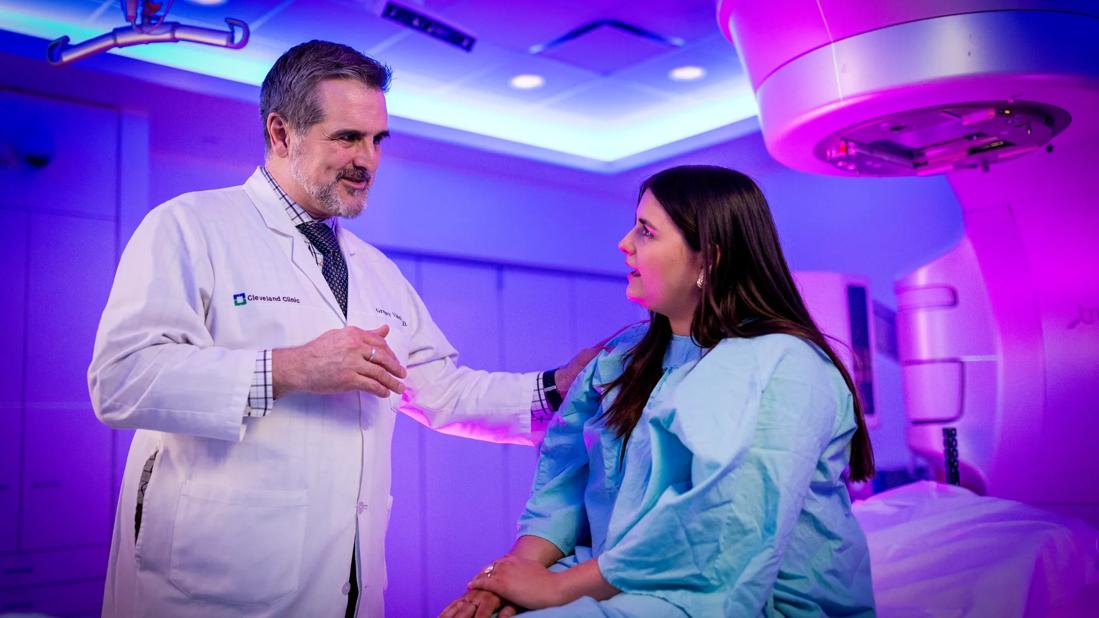Fine-tuning radiation for recurrent cancers

Historically, the idea of giving radiation a second time was taboo, but as technologies and data regarding retreatment of an area advanced, radiation oncologists have been able to shape radiation treatments to help patients with recurrent disease with reirradiation. For example, In the 2010s, national trials demonstrated that re-irradiation could be performed safely and effectively for patients with breast cancer. Today, advanced radiation centers offer re-irradiation that can be fine-tuned utilizing new radiation regimens in conjunction with the latest technology and techniques.
Advertisement
Cleveland Clinic is a non-profit academic medical center. Advertising on our site helps support our mission. We do not endorse non-Cleveland Clinic products or services. Policy
The feasibility of these approaches depends on many factors, including the type of tumor and location(s) to be treated. For example, patients with head and neck cancers often receive 70 units of radiation for five to seven weeks at initial diagnosis; in the setting of recurrences, reirradiation was studied but often delivered twice daily for several weeks, which is very challenging for patients. However, an ongoing national trial led by Cleveland Clinic radiation oncologist Shlomo Koyfman, MD is evaluating delivery of five treatments of stereotactic body radiotherapy (SBRT) with or without pembrolizumab for patients with recurrent or second primary head and neck cancers.
Similarly, for lung cancer or lung metastases having previously received radiation therapy, Gregory Videtic, MD and Kevin Stephans, MD have used re-irradiation with SBRT (in one to five treatments) to address mediastinal nodes and/or lung lesions. Repeat radiation is also possible to administer intraoperatively in some cases, such as in recurrent colorectal cancers, through research led by Ehsan Balagamwala, MD and Sudha Amarnath, MD.
Imaging advances such as prostate-specific membrane antigen (PSMA) PET scans have proven helpful for guiding radiation oncologists in determining when limited locoregional recurrences are present and therefore where re-irradiation may be appropriate in prostate cancer. In such cases, prostate cancer experts such as Rahul Tendulkar, MD and Omar Mian, MD can consider SBRT or brachytherapy to treat these recurrences.
Advertisement
“With advanced imaging such as PSMA PET scans, we can perform targeted re-irradiation, which may extend to multiple disease sites in the years to come,” says Cleveland Clinic Director of Breast Radiation Oncology Chirag Shah, MD.
This approach is also applicable in challenging areas such as breast tissue. National studies have demonstrated good outcomes with re-irradiation of breast cancer. “This specialized treatment can be done safely in a multidisciplinary setting, working on conjunction with breast surgeons and plastic surgeons,” says Dr. Shah.
This course of treatment may be appropriate for:
“Mastectomy is still the standard of care in patients with local recurrences following previous radiation, but for patients who wish to avoid a mastectomy, this can be an option,” says Dr. Shah.
A national prospective phase 2 trial evaluated repeat lumpectomy and re-irradiation in these cases, and found it was safe and effective with low rates of side effects. However, re-irradiation can be associated with wound complications, and this is one reason having surgical colleagues on the care team is crucial.
For providers looking to refer a patient to a cancer center for re-irradiation, there are many factors to consider, such as the center’s level of expertise and their comfort level performing re-irradiation, their experience determining dose composites as well as the technology available to delivering treatment.
Advertisement
The possibility for re-irradiation will depend on many elements, such as the dose of initial treatment and how long ago it took place. Dr. Shah recommends that providers keep an open mind when considering repeating radiation therapy. “People are often surprised that this is an option, but in many cases it can really help patients.”
Having treated many patients with progressive CNS tumors such as high-grade gliomas, the Brain Tumor team at Cleveland Clinic’s Taussig Cancer Center has offered numerous strategies for re-irradiation of CNS tumors. “We need to be very thoughtful about approaching re-irradiation, because tissue that has received treatment never fully ‘forgets’, so you want as much recovery time as possible between initial and repeat treatment,” says Erin Murphy, MD.
Currently, the team has three techniques available:
Advertisement
As with any therapy, there are risks to counsel patients about. “An experienced team that includes radiation and medical oncologists, radiation physicists and radiation therapists familiar with planning and delivering these techniques is critical to minimize risks,” says Dr. Murphy.
Advertisement
Advertisement

Reconsidering axillary lymph node dissection as well as depth of surgical margins

Ultra-Hypofractionated Whole Breast Irradiation and Partial Breast Irradiation Reduce Many Toxicities

Best practices for reducing toxicities

Partnerships with local social service agencies key to program success

Findings may guide future research and personalized treatments

Real-world results reporting aims to make treatments safer and more effective

Ongoing clinical validation refine breast cancer risk substratification

Phase 3 trial found no survival differences between weekly or biweekly doxorubicin/cyclophosphamide or between weekly or biweekly paclitaxel